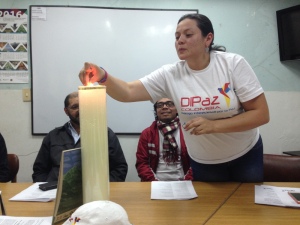Angélica Rincón could not stop smiling. All around her, crowds of people cheered and waved signs, banners and Colombian flags. Rincón – like others who have worked with MCC Colombia’s partners [Justapaz] – had longed for this turning point toward peace for many years.
After nearly four years of negotiations, [a historic peace accord] effectively ended the longest-running armed conflict in the Western hemisphere. Fighting between diverse armed groups has killed some 260,000 people and displaced close to 7 million since 1958. (Elizabeth Phelps, Saying goodbye to war and hello to peace in Colombia.)
This week churches and community groups across Colombia will be marking the International Day of Peace – September 21. For years churches, organizations and communities across Colombia, including many of MCC’s partners like Justapaz, have come together to celebrate this day with a call to action – calling for the basic necessities of life – Pan y Paz (Bread and Peace). A positive peace is more than a lack of armed conflict; it is a world where everyone has enough to eat and all are able to live without fear. On this day churches and communities march through the streets with candles, singing songs of hope and peace and offering bread to everyone they pass.

Angélica Rincón of MCC partner Justapaz lights a candle for peace. Photo courtesy Anna Vogt
In September 2014, in my first blog post as policy analyst for the Ottawa Office and while still working in Colombia, I shared the hopes and dreams for peace of a small community just outside of Bogota, San Nicolas in Soacha. Residents of San Nicolas, especially the youth, have long felt the impacts of violence and threats of violence on a very regular basis. After more than five decades of armed conflict, the cries ringing out from this community represent the cries from across Colombia – “We just want peace.”
The political context in Colombia is quite different in September 2016. After almost four years of peace talks, the Colombian government and the largest and longest running guerrilla group, the Armed Revolutionary Forces of Colombia (FARC), have announced peace accords, coupled with a bilateral ceasefire and an action plan for implementation. The announcement of the ceasefire was made in late June – resulting in celebrations throughout the streets of Bogota – and the final agreement was reached by both parties at the end of August 2016, with the objective of signing the accords on September 26.
The peace accords themselves follow the original agenda of the negotiations:
- Political participation in the national arena for the FARC;
- Agrarian reform aimed at supporting small-scale land owners and property rights;
- Greater investment in legal crops, creating incentives for farmers to disengage from the illicit economy;
- Commissions and special courts to hear directly from victims of the armed conflict;
- A roadmap to wide scale demobilization of the FARC, to be monitored by international bodies.
One could say we are just beginning generations of work. MCC’s partner organizations and staff, such as Justapaz, have worked tirelessly for years in the lead-up to negotiations, and connecting with communities and civil society as the talks progressed. But the work is hardly over.

MCC workers, together with partners, celebrate the June 2016 announcement of coming peace accords. Photos courtesy Anna Vogt
The first step is gaining approval from Colombians in a national plebiscite (referendum) to be held on October 2, 2016.
But beyond this lies the challenge of turning the peace accords into reality. Although the announcement of accords was publicly celebrated in the streets of Bogota, how will the various regions respond to the post-accord era? Many critics claim past demobilization processes of other armed groups had significant problems. Will disarmament, support for development and recovery reach all corners of Colombia? And how can the government accommodate the needs and concerns of over 6 million victims of forced displacement? Critics of the accords also claim excessive leniency was granted to both FARC and government perpetrators. Plus, the roots of the 50+ year conflict run very deep, relating to longstanding inequality and access to land and resources. Finally, many Colombians are hesitant to trust this process, as several previous attempts by the FARC and the government to reach a sustainable peace agreement have failed.

Photo courtesy Anna Vogt
Despite the excitement around the peace agreement, MCC’s partners across the country, as reported by staff on the ground share many of these and other concerns. Integral peace goes beyond high level negotiations. Integral peace calls for a just society where everyone has access to sufficient food, resources and livelihoods; where everyone across the country can live in dignity and pursue their dreams; where people can live without fear or the imminent threat of violence.
As churches and communities mark September 21 this year, calling for Pan y Paz, my thoughts and prayers continue to follow the communities across the country, rural and urban, including Soacha, where communities and local leaders stand up for peace and justice, despite continuing challenges. My prayer is that this year’s Pan y Paz continues to reflect calls for peace and dignity throughout the communities of Colombia, as the country begins to move down the long and challenging road to peace.
By Rebekah Sears, policy analyst for the Ottawa Office. This post was originally published on the MCC Ottawa Notebook.
